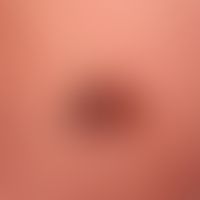Image diagnoses for "Torso", "Plaque (raised surface > 1cm)"
265 results with 950 images
Results forTorsoPlaque (raised surface > 1cm)

Acrokeratosis paraneoplastic L85.1
Acrokeratosis paraneoplastic: the thoracic view shows disseminated, yellowish-brownish keratotic plaques, which condense in the area of the Areolae mamillae as well as centrothoracally in the sternal region; in the sternal region aspect of the seborrhoeic eczema (but the inflammatory component is missing).

Atopic dermatitis (overview) L20.-
Eczema atopic (overview): severe, universal (erythrodermic) atopic eczema. exacerbation phase since about 3 months. patient with rhinitis and conjunctivitis with pollinosis. total IgE >1.000IU.

Ilven Q82.5
ILVEN: 5-year-old girl in whom flat and linear plaques in a characteristic arrangement along the Blaschko lines were noticed since the first year of life (not detectable at birth). This bizarre pattern marks the changes as a cutaneous mosaic and thus as a harmlessoma of the skin. For half a year the inflammatory character has been increasing.

Atopic dermatitis (overview) L20.-
Extrinsic atopiceczema: eminently chronic, somewhat asymmetrical eczema with blurred, itchy, red, rough, flat plaques. known (only slightly pronounced) rhinoconjunctivitis allergica. I.A. variable course with activity spurts ("overnight"). IgE normal. no atopic FA.

Circumscribed scleroderma L94.0
Generalized circumscribed scleroderma: large-area evenly indurated sclerosis of the skin, skin with a shiny, reflective surface.

Seborrheic dermatitis of adults L21.9
dermatitis, seborrhoeic: 58-year-old patient with negative self- and family history of psoriasis. recurrent HV in the seboohoeic zones of the trunk for years. no itching. improvement in summer. multiple, chronically inpatient, figured, borderline, temporarily itching, moderately scaly, clearly borderline hardly elevated plaques.

Urticaria vasculitis M31.8
Urticarial vasculitis. 33-year-old female patient with distinct reduction of the az. 3 weeks of recurrent febrile attacks (CRP and SPA massively increased) and a distinct feeling of illness accompanied by a maculo-papular, moderately itchy exanthema. Histological: Evidence of a leukocytoclastic "small vessel vasculitis". The clinical differentiation from urticaria is possible by marking a persistent efflorescence for several days (marking test). Recurrent and changing arthritis.

Naevus melanocytic common D22.-
Common melanocytic nevus:Symmetrically structured melanocytic compound nevus of junctional and dermal cell nests with basal maturation coveredby papillomatous squamousepithelium. The nests are superficially discontinuously pigmented, accompanied by melanophages. The squamous epithelium is narrowed and with elongated reticules, covered by lamellar hyperkeratosis.
Extension along the hair follicles in strands, here partly neuroid cytomorphology of melanocytes.

Acrokeratosis paraneoplastic L85.1
Acrokeratosis paraneoplastic: acquired, symptomless, brownish verrucous hperkeratosis of the nipples.

Melanoma superficial spreading C43.L
Melanoma malignes superficially spreading: pigmentation mark known and growing for years. No subjective complaints. The melanoma grows asymmetrically (no axial symmetry) with irregular pigmentation and depigmentation zones.

Nevus spitz D22.-
Naevus Spitz: Incident light microscopy of the tumor clinically shown above; irregular pigmentation; black dots.

Radiodermatitis chronic L58.1
Chronic radiodermatitis: Condition following radiation of a bronchial carcinoma.

Mycosis fungoides C84.0
Mycosis fungoides: Plaque stage. 32-year-old male with multiple, disseminated, 1.0-5.0 cm large, moderately itchy, hardly consistency increased, red, rough plaques; clinically and histologically no detectable LK infection.

Contact dermatitis toxic L24.-
Toxic contact dermatitis: 42-year-old patient who noticed these painful, red plaques after accidental contact with a corrosive fluid.

Galli-galli disease Q82.8
Galli-Galli, M. Disseminated, spotted, partly also confluent red-brown spots, papules and plaques.

Melanoma superficial spreading C43.L
Melanoma, malignant, superficially spreading: superficially spreading malignant melanoma. Enlargement stage of the preliminary picture. Moderately sharply edged, brown-black plaque. No complaints.








